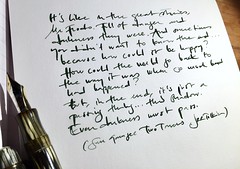Grey weather brings out the luscious green. This was my view today when I was writing on my paper. Calm and peaceful – the scenery outside is the Old Cemetery of Uppsala. A beautiful graveyard in the heart of the academic part of Uppsala. One reaches, at least, three university libraries within a few minutes walk from the Old Cemetery. This is the youngest of the three and is named after one of the big Swedish poets during the 20th century: Karin Boye (1900-1941).  I began to read her poetry in my early teens and I think that made poetry a part of my life. My poetry reading is very periodic – it can pass months without me reading a single line and then something happens that makes me urge for poetry, which often leads me to reread and find new perspectives on old darlings and find new darlings that manage to get under my skin. I was very happy to be reminded of Karin Boye and her poetry today – it has been a long time since I read her properly. When I came home I browsed my worn collection of her poems – like reuniting with an old friend and remember what a good and interesting friend it is – wondering why on earth we don’t see each other more often. I was also thrilled to find a web site with good translations of her work into English. Especially Jenny Nunn’s translations are excellent as they manage to capture the urgency and personality of Karin Boye’s voice. She is complex, but her poetry is often seemingly simple. The rhythm (in Swedish) is as made for recitation – sometimes almost like an ancient, Greek, choir – urgent, passionate and very alive. (Photo of Karin Boye above is from a library page).
I began to read her poetry in my early teens and I think that made poetry a part of my life. My poetry reading is very periodic – it can pass months without me reading a single line and then something happens that makes me urge for poetry, which often leads me to reread and find new perspectives on old darlings and find new darlings that manage to get under my skin. I was very happy to be reminded of Karin Boye and her poetry today – it has been a long time since I read her properly. When I came home I browsed my worn collection of her poems – like reuniting with an old friend and remember what a good and interesting friend it is – wondering why on earth we don’t see each other more often. I was also thrilled to find a web site with good translations of her work into English. Especially Jenny Nunn’s translations are excellent as they manage to capture the urgency and personality of Karin Boye’s voice. She is complex, but her poetry is often seemingly simple. The rhythm (in Swedish) is as made for recitation – sometimes almost like an ancient, Greek, choir – urgent, passionate and very alive. (Photo of Karin Boye above is from a library page).
The poem below is perhaps – along with “On the move” – the most spread and quoted of Karin Boye’s poems. Since it is so often quoted and has been used so many, many times in various settings I have almost become blind to it – as one tends to with hits, but it is great poetry. Seeing a text translated into another language sometimes brings new perspectives to it and the translation by Jenny Nunn brought it to life again.
Of Course It Hurts
Of course it hurts when buds burst.
Otherwise why would spring hesitate?
Why would all our fervent longing
be bound in the frozen bitter haze?
The bud was the casing all winter.
What is this new thing, which consumes and bursts?
Of course it hurts when buds burst,
pain for that which grows
and for that which envelops.
Of course it is hard when drops fall.
Trembling with fear they hang heavy,
clammer on the branch, swell and slide –
the weight pulls them down, how they cling.
Hard to be uncertain, afraid and divided,
hard to feel the deep pulling and calling,
yet sit there and just quiver –
hard to want to stay
and to want to fall.
Then, at the point of agony and when all is beyond
help,
the tree’s buds burst as if in jubilation,
then, when fear no longer exists,
the branch’s drops tumble in a shimmer,
forgetting that they were afraid of the new,
forgetting that they were fearful of the journey –
feeling for a second their greatest security,
resting in the trust
that creates the world.
(Translated from Swedish to English by Jenny Nunn – you find more of her excellent translations of Boye’s poems here)
(Detail of the very unglamorous façade of the building that – amongst other departments houses the Karin Boye library).
Below is one of my personal favourites of her poetry – also this in translation by Jenny Nunn. I love the strong will, the yearning and the quest for truth here. She is formidable with a very special voice. Check out more about her and her poetry here.



You have a lovely view from your windows.
Dave
Pingback: Tweets that mention poetry brought to mind at the library | lady dandelion -- Topsy.com
Such a dramatic difference in the view inside and outside.